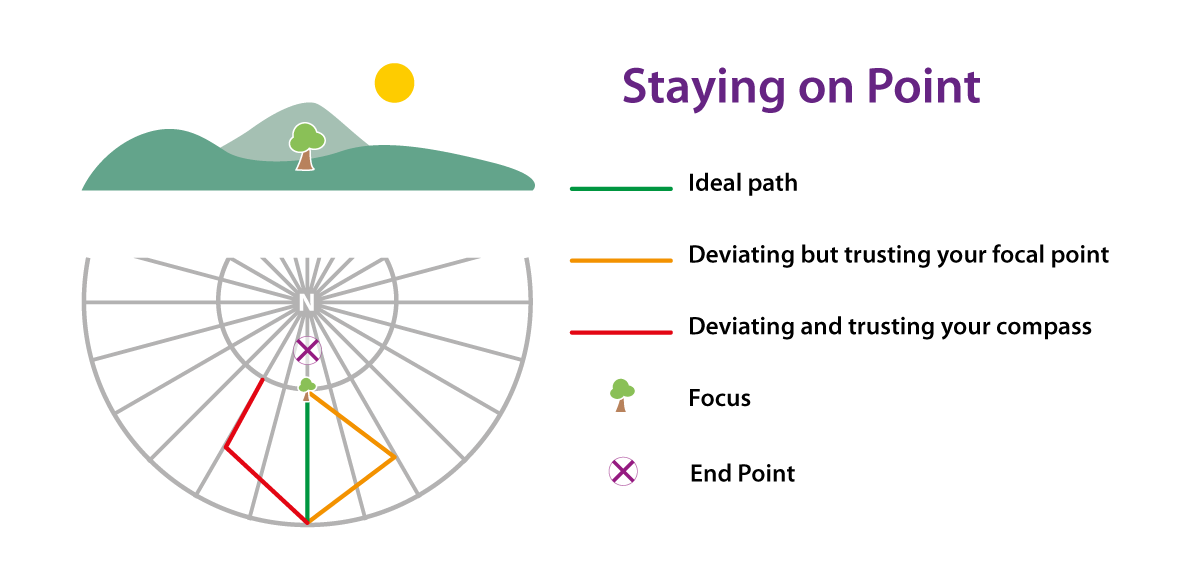But having a map will help
One of my favourite life lesson illustrations comes from my experience in the Venture Scouts. Though I didn’t give myself the credit at the time, I was pretty good at map & compass work. One important principle in orienteering is that once you’ve established your location and figured out in which direction you need to go, you put your map and compass away. What you do is fix your sights on a visible landmark that lines up with your direction of travel. So long as you’re heading towards that landmark you will stay on course.
To illustrate this I’ve created a scenario in which your direction of travel is due North towards your destination marked by an X (illustration below). So you pick out a landmark and head for it. When you arrive at the landmark you take out your compass and find another landmark that’s due North. As shown by the orange line, it doesn’t matter if you go off course so long as you have the landmark in view.
The red line represents someone relying solely on their compass. The problem here is that you will inevitably deviate from your path and while you continually follow due North you could easily miss your desired destination by some distance.

We often take the third (red) route as we attempt to figure out our place in the landscape of human experience while many self help programmes assume a kind of true north. But we all deviate from the norm in ways we are not necessarily aware and the more you deviate the less reliable your compass. Another reason for not following your compass is that you need to watch your footing and keep your hands free in case you trip. Watching the compass is a distraction and a hindrance.
We are all different and have our own learning paths but I generally find that I learn more when I’m less focused on getting there. By putting my map and compass away I am more grounded and aware of what is around me. When I’m aware of others, and not in my own bubble, I can better triangulate my position and direction of travel. It can be reassuring to arrive at the same point as other travellers while en route to our own goal even though we’ve taken different routes. While the ultimate goals might be wildly different, there are common intermediate steps because that’s how life works.
As a teenager I found the TV series, Kung Fu, inspirational. I loved the idea of self reflection and finding myself. Though not habitually, I have practiced meditation and found it helpful. But I’m unconvinced of the benefit of finding oneself in a period of isolation. Individually we can reset our true north but, like a jigsaw piece, it’s only within the context of those we interact with that we can truly find ourselves. The experience of others acts as landmarks in our quest for the holy grail.
We are all sojourners, with each map covering common ground but at different scales. Our compasses differ in quality and precision but all point to North. Obstacles and circumstances repeatedly knock us off track but when our focus is on what benefits us all, our individual and desired destinations are mutually assured.
We are still in the middle of a Covid crisis and looking back we can see we’re here partly because appropriate intermediate steps were not taken. It’s a given that the long term goal is to get the virus under control but for some the focus was on protecting the economy while for others it was on public health. In each scenario there were intermediate steps to be taken. Ultimately, none of the strategies work unless the footwork is put in and continual recalibrations are made.

Like the pandemic, my own life is difficult to predict with any certainty. The pursuance of a goal beyond the horizon is not well served by doggedly following my compass. The lesson I learn in one situation might not be transferrable to another, general principles need to be contextualised and rules should be subject to challenge. Ultimately I might decide that where I wanted to end up is not where I would be happiest.
I hadn’t properly thought this out when I began writing though I knew the principle was sound, if only for those going hiking and not being well practiced in using a map and compass. But the more I’ve worked the story the more the principle of fixing on an identifiable objective makes sense. And that being ‘one with the universe’ primarily means immersing myself in what is immediately ahead.
